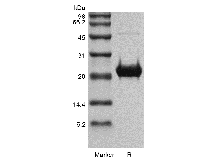- Source
- Escherichia coli.
- Molecular Weight
- Approximately 21.8 kDa, a single non-glycosylated polypeptide chain containing 195 amino acids.
- AA Sequence
- MRPLAFSDAG PHVHYGWGDP IRLRHLYTSG PHGLSSCFLR IRADGVVDCA RGQSAHSLLE IKAVALRTVA IKGVHSVRYL CMGADGKMQG LLQYSEEDCA FEEEIRPDGY NVYRSEKHRL PVSLSSAKQR QLYKNRGFLP LSHFLPMLPM VPEEPEDLRG HLESDMFSSP LETDSMDPFG LVTGLEAVRS PSFEK
- Purity
- > 95 % by SDS-PAGE and HPLC analyses.
- Biological Activity
- Assay #1: Fully biologically active when compared to standard. The biological activity is measured by its binding ability in a functional ELISA. Immobilized rHuFGF R4 at 5 µg/ml can bind rHuFGF-19 with a linear range of 3-200 ng/ml.
Assay #2: Fully biologically active when compared to standard. The ED50 as determined by a cell proliferation assay using murine Balb/c 3T3 cells is less than 150 ng/ml, corresponding to a specific activity of > 6.7 × 103 IU/mg.
- Physical Appearance
- Sterile Filtered White lyophilized (freeze-dried) powder.
- Formulation
- Lyophilized from a 0.2 µm filtered concentrated solution in PBS, pH 7.4.
- Endotoxin
- Less than 1 EU/µg of rHuFGF-19 as determined by LAL method.
- Reconstitution
- We recommend that this vial be briefly centrifuged prior to opening to bring the contents to the bottom. Reconstitute in sterile distilled water or aqueous buffer containing 0.1 % BSA to a concentration of 0.1-1.0 mg/mL. Stock solutions should be apportioned into working aliquots and stored at ≤ -20 °C. Further dilutions should be made in appropriate buffered solutions.
- Stability & Storage
- Use a manual defrost freezer and avoid repeated freeze-thaw cycles.
- 12 months from date of receipt, -20 to -70 °C as supplied.
- 1 month, 2 to 8 °C under sterile conditions after reconstitution.
- 3 months, -20 to -70 °C under sterile conditions after reconstitution.
- Usage
- This material is offered by Shanghai PrimeGene Bio-Tech for research, laboratory or further evaluation purposes. NOT FOR HUMAN USE.
- Reference
- 1. Ladher RK, Anakwe KU, Gurney AL, et al. 2000. Science. 290:1965-7.
2. Tomlinson E, Fu L, John L, et al. 2002. Endocrinology. 143:1741-7.
3. Smallwood PM, Munoz-Sanjuan I, Tong P, et al. 1996. Proc Natl Acad Sci U S A. 93:9850-7.
4. Fu L, John LM, Adams SH, et al. 2004. Endocrinology. 145:2594-603.
5. Kharitonenkov A, Shiyanova TL, Koester A, et al. 2005. J Clin Invest. 115:1627-35.
6. Kurosu H, Kuro OM. 2009. Mol Cell Endocrinol. 299:72-8.
7. Lin BC, Wang M, Blackmore C, et al. 2007. J Biol Chem. 282:27277-84.
8. Kharitonenkov A, Dunbar JD, Bina HA, et al. 2008. J Cell Physiol. 215:1-7.
- Background
- Human FGF-19 is encoded by the FGF19 gene. FGF-19 belongs to the FGF-19 subfamily which has three members FGF-19, 21, 23. FGFs are classically considered to be paracrine factors and are known for their roles in tissue patterning and organogenesis during embryogenesis. By contrast, the FGF-19 subfamily has recently been shown to function in an endocrine manner. Members of this subfamily have poor ability of binding to heparin binding site which is a crucial factor in ligand-receptor complex formation. β-Klotho has been identified as co-factor required for FGF-19, 21, 23 signaling. It can obviously increase ligand-receptor affinity. Unlike most FGFs which bind to and activate more than one FGF receptor, FGF19 is a specific ligand for FGF R4. In FGF-19 transgenic mice, reducing liver triglycerides, increasing fatty acid oxidation, reducing glucose levels and improving insulin sensitivity can be observed.








 COA Application
COA Application


